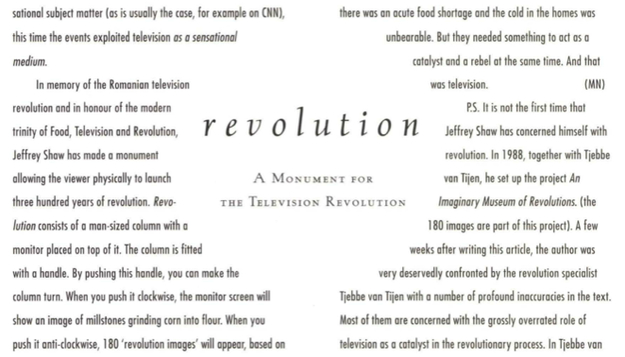One moment of despoir prooved to be enough to turn the bulwark of power into a house of cards und to bring it down. Television painfully revealed the confusion of Elena and Nicolae Ceousescu as they had to stand by and watch from the balcony how the staged party demonstration suddenly turned against them. The spark caught on - with the help of television - and on Thursday afternoon, 21 December 1989, Romania was overwhelmed by revolution.
-
From one day to another, Romanian television underwent a total change: from a dictatorial and repressive medium into o really democratic and revolutionary one. At last its true power could start to flourish, at last it could show, as an extension of the eye, what it was capable of. While we were only allowed to receive their revolution in doses, the Romanians could follow it in real time ond unedited. This time it wos not the television exploiting the events as sensational subject matter (as is usually the case, for example on CNN), this time the events exploited television as a sensational medium.
In memory of the Romanian television revolution and in honour of the modern trinity of Food, Television and Revolution, Jeffrey Shaw has mode a monument allowing the viewer physically to launch three hundred years of revolution. Revolution consists of o man-sized column with a monitor placed on top of it. The column is fitted with a handle. By pushing this handle, you can make the column turn. When you push it clockwise, the monitor screen will show an image of millstones grinding corn into flour. When you push it anti-clockwise, 180 'revolution images' will appear, based on iconographic material from the same period as the revolutionary event (by means of collage, colouring, distortion and drawing, the meaning of the original visual material is enhanced and renewed). Therefore, the installation is a kind of time machine which takes you bock in time from the Romanian television revolution and allows you to survey three hundred years of revolutions.
Since all of the 180 images are included in one rotation (so that each image is only visible over two degrees), you will hove to turn the column very slowly to see the images one by one. When you turn it faster, you will see nothing but a vague and blurred moss of rebellious images. Consequently, without the viewer/activist nothing happens: no flour is ground, no revolution unchained. The viewer is an essential part of the installation. It is his task to set the images of the revolution in motion. He has to launch the revolution himself. Without him, the installation has no meaning.
The basic idea behind Revolution is that the television screen carries the germs of the revolution, and that the viewer's action is an action towards the medium, that is: towards the revolution. The installation is a monument for the present relation between media and revolution - even if the images refer to previous revolutions and even if the Romanian revolution was short-lived (os everybody knows, after the formation of the Romanian National Rescue Front, television became as repressive a medium as before). Revolution is not only dedicated to Television and Revolution but also to Food, the corn turned into flour by the millstones. Because we hod better not believe that the Romanians rebelled on purely idealistic grounds: there was an acute food shortage ond the cold in the homes was unbearable. But they needed something to act as a catalyst and a rebel at the same time. And that was television.
P.S. It is not the first time that Jeffrey Shaw has concerned himself with revolution. In 1988, together with Tjebbe van Tijen, he set up the project An Imaginary Museum of Revolutions, (the 180 images are part of this project). A few weeks after writing this article, the author was very deservedly confronted by the revolution specialist Tjebbe von Tijen with a number of profound inaccuracies in the text. Most of them are concerned with the grossly overrated role of television as a catalyst in the revolutionary process. In Tjebbe van Tijen's opinion, television is instrumental not catalytic. For example, the confrontation in Timisoara hod already taken place before Elena and Nicolae Ceausescu's notorious balcony scene.
Furthermore, there ore rumours (and even evidence) that the television revolution was no more than a farce. Romanian television does not appear to have changed at all: as ever, it feeds on blood, violence ond death. So the Romanian television revolution is nothing more thon an episode of the television serial The Great Revolutions (we could even seriously consider the question of whether this television revolution really happened at all). All this proves once more how dangerous it is to abandon yourself to euphoria. From now on we will look at television with a cold piercing gaze, once again. (MN)
Mediamatic Magzine vol 5#1+2 1 Jan 1990
Revolution
The Artists
A monument for the television revolution
